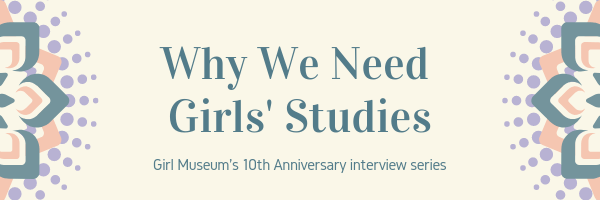
Welcome to Girl Museum’s 10th Anniversary year. We have many exciting projects for our community, including this new blog series, Why We Need Girls’ Studies. Each month we will feature an interview with a scholar in the field to get insights about what we are all doing in this space to further our understanding of girlhood and its experiences.
Our tenth interview is with Dr. Lynne Vallone, Professor of Childhood Studies, at Rutgers University-Camden, New Jersey.
Let’s begin with defining our terms, especially since Girls’ Studies is a relatively new academic area. Can you tell our readers what your field of expertise is and how you see it within Girls’ Studies?
My general academic expertise is in Childhood Studies—and I link Girls‘ Studies with that very broad field of inquiry. Specifically, I locate my work at the intersections of social, cultural and literary and gender history as they impact youth, particularly various constructions of youth. Although I am most comfortable working in the past, lately, I’ve been interested in how girls and young women have been constructed as “activists“ on either side of the abortion debate in the present moment.
Why do you think we need Girl Studies?
Like all “area studies” (such as Childhood Studies, Animal Studies, Gender Studies, etc.), Girls’ Studies allows for focused research on topics, texts, and persons/subjects that have historically been overlooked or subsumed under larger categories. The specificities of girls’ cultures, for example, can be lost if we think only about age and not gender, for example. Girls’ Studies work never functions in isolation, of course, and makes natural alliances with critical race theory or feminist theory and/or a multitude of tools for understanding the lives of girls and constructions of girlhood over time and in different locations and positions. Girls have always contributed to culture and these contributions, as well as their specific needs, should be recognized and celebrated.
There are vast disparities globally in girls’ situations, with incremental improvements in some areas and serious steps backwards in others. From your work in Girls’ Studies, what are some positives you take away from the academic interest in girls and girlhood? What changes can it lead to?
Attention paid to girls’ lives, their voices and interests, their struggles and successes (however they define them) can help to change their situations through awareness. I do not, unlike many Girls’ Studies scholars, typically perform activist-centered research, but I hope that my work on girls and obesity or girl activism spotlights ways in which American culture, in particular, constructs, defines, fears and desires the girl. This knowledge, I think, can spur critical thinking and change in the ways in which we interact with girls.
What are the biggest challenges now and going forward for Girls Studies in an academic world? Do you see Girls’ Studies programs being a reality?
I think that the future for Girls’ Studies is bright—even if we don’t see many discrete programs of Girls’ Studies springing up in colleges and universities around the world. New programs can be expensive and time consuming to start and maintain. However, I believe that Girls’ Studies coursework and research will grow because one of the strengths of Girls’ Studies is in looking at problems or topics across disciplines. Interdisciplinary research and collaborations are more than a trend in the academy today; they are an established and productive research mission. Girls’ Studies concentrations can be formed in multiple ways, encouraging buy-in and energy from across fields and disciplines.
We have an ongoing research question we ask everyone we interview: Do you think the Internet is a safe place for girls and why?
I think that the answer to this question depends, in part, on the age of the girl, yet I don’t think that I would call the Internet a “safe place” for anyone, really, given its incoherence and competing demands as a commercial, educational, social, artistic, and political “space.” This doesn’t mean that I think that girls have no place within the morass of the internet, given the many positives that it has brought to girls in knowledge, pleasure, support, etc. However, I think that girls (and everyone) need to be aware and vigilant when using the Internet.
Dr. Vallone was the chair of the Department of Childhood Studies from 2008 until 2011 and again from 2013-2016. She is the author of Big and Small: A Cultural History of Extraordinary Bodies (2017, Yale UP), Disciplines of Virtue: Girls’ Culture in the Eighteenth and Nineteenth Centuries (1995, Yale UP) and Becoming Victoria (2001, Yale; a cultural biography of the young Queen Victoria) and the co-editor of The Norton Anthology of Children’s Literature (2005, Norton), Virtual Gender: Fantasies of Subjectivity and Embodiment (U of Georgia P), The Girl’s Own: Cultural Histories of the Anglo-American Girl, 1830-1915 (1994, U of Georgia P), and The Oxford Handbook of Children’s Literature (2011, Oxford UP). In 2011, The Oxford Handbook of Children’s Literature was awarded the Children’s Literature Association’s best edited book prize. She is general editor of the Palgrave series Literary Cultures and the Child. Her current work historicizes the cultural and political identities of the fetus.
Join us next month for another interview of a Girlhood Studies scholar, Dr. Anuppiriya Sriskandarajah of York University.
Thanks for reading!
-Ashley E. Remer
Head Girl
Girl Museum Inc.
